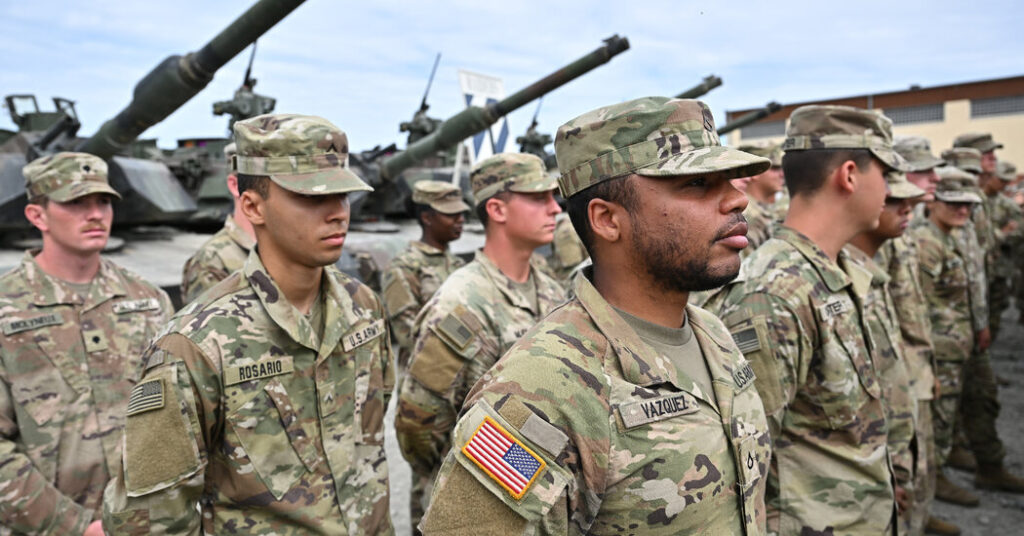U.S. defense officials raised the security alert level at European military bases over the weekend in response to vague threats from the Kremlin about Ukraine’s use of long-range weapons on Russian soil, according to U.S. and Western officials.
Officials said they have not yet collected specific intelligence about possible Russian attacks on U.S. bases. Any such attack by Russia, whether overt or covert, would result in a major escalation of its war in Ukraine.
Russia has been stepping up sabotage activities in Europe in the hope of stemming the flow of supplies to Ukraine. So far, no U.S. bases have been targeted by the attacks, but U.S. officials said the increased alert level will help ensure military personnel remain alert.
Throughout the war, U.S. officials assessed that President Vladimir V. Putin was unwilling to expand the war beyond Ukraine’s borders.
But stepped-up U.S. and European aid efforts and loosening restrictions on how supplies can be used have caused panic in Moscow, according to U.S. officials. Russia’s recent rhetoric has alarmed some U.S. and European officials.
Ukraine has been using U.S. long-range missiles called “ATACMS” to strike deep into the occupied Crimea region. The United States has also said Ukraine could use them to conduct cross-border attacks against Russian military targets.
The attack on Crimea prompted Russia to summon the U.S. ambassador, Lynne M. Tracy, to the Foreign Ministry. On June 24, a Kremlin spokesman said that any direct American involvement in the war that resulted in the death of Russians “must have consequences.”
Following Britain’s decision to provide Ukraine with Storm Shadow cruise missiles, the United States decided to provide long-range weapons and relax restrictions on their use. Kiev has used these weapons to attack military targets in Crimea.
Strikes with Western weapons, especially in Crimea, have proven effective, damaging Russian army logistics centers and further weakening Russia’s Black Sea Fleet.
But the success of the attack prompted Moscow to look for ways to thwart further attacks.
In recent months, Russia has stepped up a series of sabotage activities in many places in Europe. The operation, run by Russian military intelligence, was at times ham-fisted, including causing a fire in an Ikea store. But Nato has repeatedly warned about these incidents, and Britain expelled a Russian military attache after a fire broke out at a London warehouse.
Even if there is no specific intelligence that Russia is considering such an attack, military bases that provide training, intelligence and other support to Ukraine could be logical follow-up targets.
Protecting military bases and the people who live and work within them falls under what the Pentagon often calls protection by force. Beyond simple fencing or guards protecting base gates, this includes a range of increasingly stringent security measures that can be implemented in proportion to the given threat.
Most U.S. military installations around the world are in the second-lowest such environment, known as force protection condition “Alpha,” which includes measures such as directing officials to test their communications equipment and increasing spot checks of vehicles and personnel entering bases.
At the other end of the spectrum are conditional “deltas”, which are set when an attack is about to occur or is in progress. This level closes non-essential functions such as base schools, directs searches of all vehicles at entrances, adds more guards and severely restricts the movement of nearly everyone within a given base.
As of now, U.S. military bases in Europe are in “Charlie” status, which is the second highest level and the highest level of combat readiness that can reasonably be maintained for a long period of time.
Over the weekend, Cmdr. U.S. European Command spokesman Daniel Day said the military asked personnel to “remain alert at all times.”
European Command said in a statement on Monday that officials would not describe the steps they took to secure the operation.
“Our increased alertness is not related to any single threat, but is driven by an abundance of caution regarding multiple factors that may affect the safety of U.S. service members in the European theater,” the command said in a statement.
Eric Schmidt Contributed reporting.

